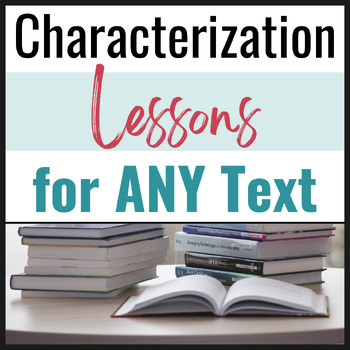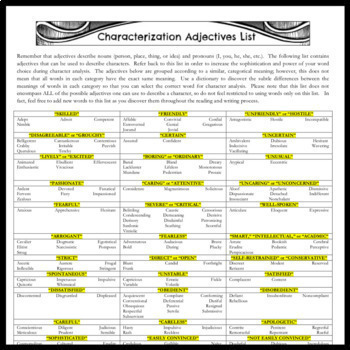Characterization Mini-lesson BUNDLE for ANY Novel or Short Story
- Zip
What educators are saying
Description
This bundle consists of 15+ multi-lesson activities to get your students involved in analyzing one of the key literary elements: characterization. In fact, all other elements and techniques generally revolve around characterization, so by working with your students to analyze character, they will also be exposed to these other devices.
This bundle is divided into two sections: “Series Activities” and “Characterization Quick-picks.” The first section is organized according to a “lead activity” that corresponds to follow-up activities. Each “lead activity” contains a “Teacher Page” that gives instructions and tips for implementation along with the Task, Objectives, Common Core Standards, and an Optional Do Now Activity.
Each “lead activity” is followed by a series of activities that are designed to stem from the “lead activity” although several of the follow-up activities can be used in isolation on their own. Each of these “follow-up” activities requires students to further explore characterization and finally to synthesize their findings into some kind of writing or presentation. This bundle is organized by “lead” activities that mostly include the following documents: Teacher Page, Lead Activity, Exploratory Activity, Interactive Activity, and Synthesis Activity (not necessarily in that order). You as the teacher can decide which activities will best fit the needs of your students and your curriculum and use them accordingly.
The second section of this bundle contains “Characterization Quick-picks,” which are a series of single characterization lessons that you can use in isolation with any piece of literature or in conjunction with any of the more structured lesson series in section one of the booklet. These “grab and go” activities are particularly useful on those days when you need a quick lesson that is aligned to the Common Core.
There are enough activities in this bundle to make characterization the entire focus of your curriculum. Use the multiple times throughout the year with different pieces of literature, or work through each activity as the year progresses.
Each of these activities is sold separately in my store. Bundle and save over $15.00!
Happy character analysis!
Activities include:
1. Characterization Adjectives List
2. Teacher Page: “Mind Jump”
3. Lead Activity: “Mind Jump”
4. Interactive Activity: “Mind Jump” Pair Discussion
5. Exploratory Activity: “Mind Jump” Character Chart
6. Synthesis Activity: “Mind Jump” Post Write-up
7. Teacher Page: “Stargram”
8. Lead Activity: “Stargram”
9. Interactive Activity: “Stargram” Discussion
10. Exploratory Activity: “Stargram” Character Change Chart
11. Synthesis Activity: “Stargram” Analytical Paragraph
12. Teacher Page: “What’s in a name?”
13. Lead Activity: “What’s in a name?” Research
14. Interactive Activity: “What’s in a name?” Pair Discussion
15. Exploratory Activity: “What’s in a name?” Chart
16. Synthesis Activity: “What’s in a name?” Analytical Paragraph
17. Teacher Page: “Relationship Rectangle”
18. Lead Activity: “Relationship Rectangle” Activity
19. Interactive Activity: “Relationship Rectangle” Group Discussion
20. Exploratory Activity: “Relationship Rectangle” Character Chart
21. Synthesis Activity: “Relationship Rectangle” Analytical Paragraph
22. Teacher Page: “Magic Mirror”
23. Lead Activity: “Magic Mirror”
24. Exploratory Activity: “Magic Mirror”
25. Interactive Activity: “Magic Mirror” VENN Diagram
26. Synthesis Activity: “Magic Mirror” Writing Task
27. Teacher Page: “Motivation Machine”
28. Lead Activity: “Motivation Machine”
29. Interactive Activity: “Motivation Machine” Silent Swap
30. Exploratory Activity: “Motivation Machine” Consequences Chart
31. Synthesis Activity: “Motivation Machine” Analytical Paragraph
32. Teacher Page: “Love Triangle”
33. Lead Activity: “Love Triangle”
34. Interactive Activity: “Love Triangle” Group Presentation
35. Exploratory Activity: “Love Triangle” Poem
36. Synthesis Activity: “Love Triangle” Analytical Paragraph
37. Teacher Page: “Character Assassination”
38. Lead Activity: “Character Assassination” Tabloid Trash
39. Interactive Activity: “Character Assassination” Tabloid Exchange
40. Exploratory Activity: “Character Assassination” Analysis
41. Synthesis Activity: “Character Assassination” Analytical Paragraph
42. Teacher Page: “Subtext Submarine”
43. Lead Activity: “Subtext Submarine”
44. Interactive Activity: “Subtext Submarine” in Literature
45. Exploratory Activity: “Subtext Submarine” Chart
46. Synthesis Activity: “Subtext Submarine” Skit
47. Teacher Page: “Characters in 3-D”
48. Lead Activity: “Characters in 3-D”
49. Interactive Activity: “Characters in 3-D” Diagram
50. Exploratory Activity: “Characters in 3-D” Character Sketch
51. Synthesis Activity #1: “Characters in 3-D” Analytical Paragraph
52. Synthesis Activity #2: “Characters in 3-D” Superhero
53. Teacher Page: ���Personality Profiles”
54. Lead Activity: “Tweet Time!”
55. Synthesis Activity: “Tweet Time” Reflection Guide
56. Lead Activity: “Facebook”
57. Synthesis Activity: “Facebook” Reflection Guide
58. Lead Activity: “Instagram”
59. Synthesis Activity: “Instagram” Reflection Guide
60. Teacher Page: “Debate Time!”
61. Sample Debate Rubric
62. “Debate Time!” #1
63. “Debate Time!” #2
64. “Debate Time!” #3
65. “Debate Time!” #4
66. “Debate Time!” #5
67. “Action!”
68. “What’s Your Anthem?”
69. “Character Comic Strip”
70. “You’ve Got Style!”
71. “Quite a Quandary!”
72. “Most Important Words”
73. “I couldn’t have done it without you!”
74. “Character ‘I Am’ Poem”
75. “What’s Your Problem?”
76. “Character Blender”
77. “Journey Journal”
78. “Timeline of Your Life”
79. “Essay Time!” Prompt #1: Symbolism Essay
80. “Essay Time!” Prompt #2: Musical Journey Essay
81. “Essay Time!” Prompt #3: Minor Character Essay
82. Essay Rubric
PERKS FOR YOU
*Join the Bespoke ELA Blog to gain access to 100+ FREE resources that are not here on TpT!
* Be sure to click the "FOLLOW" button that is located next to my picture in the profile so that you can hear about sales, new products, and freebies!
* Don't forget to leave feedback to EARN POINTS that turn into cash towards future purchases!
---------------------------------------------------------------------------------------------------
You might also like:
50 EDITABLE Projects and Assignments for ANY NOVEL STUDY
30 MENTOR SENTENCES for Literary & Rhetorical Devices with Writing Application
Poetry Bundle: 20 Short Poems to Teach Rhetorical Relationships & Explication
25 Essential Handouts for Writing Workshop
Crafting Commentary for Literary Analysis
=============================
Follow ME for UPDATES, ANNOUNCEMENTS, & FREEBIES!





